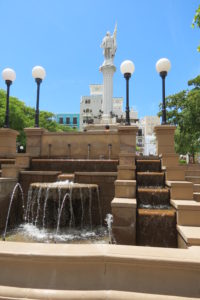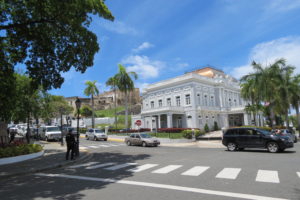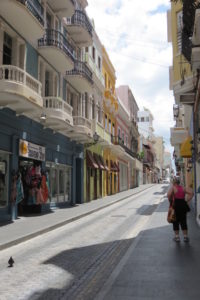About Puerto Rico
“Puerto Rico, officially the Commonwealth of Puerto Rico is an unincorporated territory of the United States, located in the northeastern Caribbean east of the Dominican Republic and west of both the United States Virgin Islands and the British Virgin Islands. Due to its location, Puerto Rico enjoys a tropical climate and is subject to hot weather all-year-round. The national language is Spanish but English is recognized as an official language as well.
In 1917, the U.S. granted citizenship to Puerto Ricans. In 1948, it granted Puerto Ricans the right to elect their own governor. In 1952, under request by the United States, a local territorial constitution was adopted and ratified
by the electorate. Under the tenets of the Puerto Rico Federal Relations Act, residents of the island are still subject to the plenary jurisdiction of the U.S. Congress, and the island continues as a U.S. territory. In 1917, the U.S. Congress passed the Jones-Shafroth Act, popularly called the Jones Act, which granted Puerto Ricans U.S. citizenship. Opponents, who included all of the Puerto Rican House of Delegates, which voted unanimously against it, said that the US imposed citizenship in order to draft Puerto Rican men into the army as American entry into World War I became likely.
Puerto Rico consists of the main island of Puerto Rico and various smaller islands, including Vieques, Culebra, Mona, Desecheo, and Caja de Muertos. Of these last five, only Culebra and Vieques are inhabited year-round. Mona is uninhabited most of the year except for employees of the Puerto Rico Department of Natural Resources. There are also many other smaller islands, including Monito and “La Isleta de San Juan,” which includes Old San Juan and Puerta de Tierra, and is connected to the main island by bridges.” (Wikipedia)
Bicardi Disterlly
After the tour guide gave us a fairly detailed description of Puerto Rico, we arrived at the Bacardi distillery. The grounds are beautiful and well taken care of. After parking the van, we disembarked and followed our tour guide to the ticket counter/pavilion. Part of our admission to the distillery included two free Bacardi drinks and the tour. The ticket representatives told our tour guide that the next tour would leave in 25 minutes. Our tour guide recommended using our drink coupons. All six of us headed straight to the bar to begin testing the Bacardi rum flavors. Some of the flavors we enjoyed were Raz, Dragonberry, Coconut, and Oakheart. Oakheart is there premium brand and aged in white oak barrels from the US mainland a lot longer. The oakheart was seriously smooth. We later learned the pavilion were sitting under is the shape of a bat. The bat is the label of Bacardi. Here is a little history about the bat label. With the development of the new Bacardi rum, in 1862 Bacardi purchased a tin roofed factory building in which he planned to start a distillery. In the roof of the building lived a family of fruit bats, considered to be a good luck omen in Cuban mythology. To this day, the official logo of the Bacardi Company bears the likeness of a fruit bat in flight.
The company was formed in 1862; the founder was Don Facundo Masso. He actually perfected his father’s formula, developing rum from yeast.
Following drinking our beverages, we boarded a tram to visit a museum of the distillery. The gentleman in the museum area explained much of the history and then walked us through reconstructed demonstration of the old manufacturing process. This was all very interesting; however, I am waiting for the real of the actual plant. However, we learned following our tour that there will not be a tour of the actual plant, we were really bummed.
Following the old manufacturing process, we headed back to the pavilion on the open-air tram. Before we departed to the next part of the tour, we visited the gift shop. We had about 45 minutes there. It was sure tempting to purchase something; however, Cindy and I really did not purchase anything real big, however just something small. I can’t reveal because it is a gift for a family member. When you purchase alcohol off the ship and then return to the ship, you have to check the alcohol in with the cruise ship. They will return the alcohol the day depart the ship. This is probably a good thing; it maintains the amount of alcohol flowing through the cruise ship.
We left the Bacardi distillery and then headed to Old Town San Juan. The trip on the van took about 20 minutes. The tour guide dropped us off at the Colon Park, really close to the San Cristobal Castle. The tour guide recommended a few restaurants in the area for lunch. He also informed us that he would pick us up at 3:15 pm and then take us to the ship. Once off the bus, we walked up Fortaleza Street. Along the way, we observed 400+ year old buildings that reminded us of Italy or Europe in general. I enclosed are photos to show what we meant. We couldn’t help to notice that down one of the side streets, there was a man lying next to a building. Marcus is able to speak Spanish, he heard them mention this person maybe dead. We did not stick around to find out, however this is really sad. Even though we were observing the beautiful sites and buildings, our first focus was to find a place to eat lunch. We settled on a small local café, on San Justo Street, which was super busy, a good sign. The name of the café is Manolin-Old San Juan. We wanted to try some local cuisine. Most of us had Mofongo Relleno con Pollo. We thoroughly enjoyed our lunch; however, our service was super slow. We are just thinking this is island time; we are just not used to it. Lunch took over an hour, so we did not really have much time to really enjoy the area of visit the fort or castle. Note to self, we need to come back and spend time in Old San Juan.









